編輯:關於Android編程
文件存儲是 Android 中最基本的一種數據存儲方式,它不對存儲的內容進行任何的格式化處理,所有數據都是原封不動的保存到文件當中的。
概述
文件存取的核心就是輸入流和輸出流。
Android文件的操作模式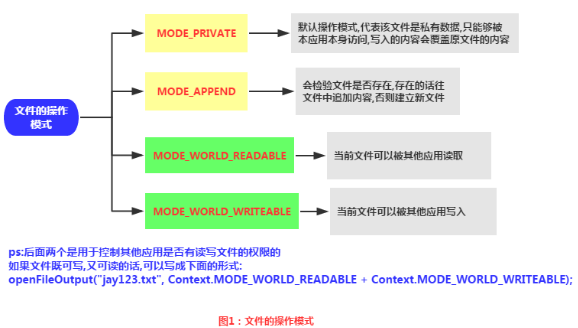
文件的相關操作方法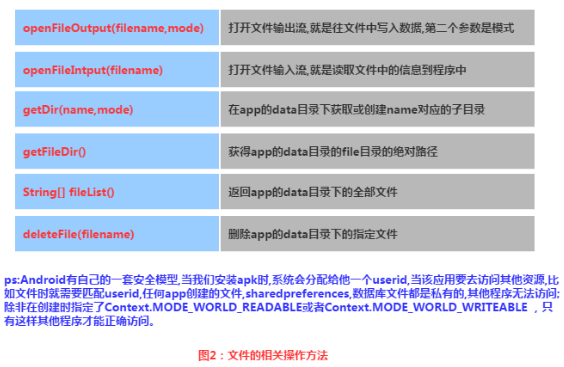
文件讀寫的實現
openFileOutput和openFileInput方法
/**
* openFIleOutput ,openFileInput
* 這兩種方法同sp一樣只能講文件保存到手機內存固定的路徑中,
* 默認為 /data/data/<packageName>/files
*/
private void save2File() {
try {
//向文件寫入內容
FileOutputStream os = openFileOutput("file.txt", Context.MODE_PRIVATE);
String text = "寫數據到文件";
os.write(text.getBytes("utf-8"));
//關閉流
os.close();
} catch (FileNotFoundException e) {
e.printStackTrace();
} catch (UnsupportedEncodingException e) {
e.printStackTrace();
} catch (IOException e) {
e.printStackTrace();
}
}
/**
*
*/
private void readFile() {
try {
FileInputStream ins = openFileInput("file.txt");
byte[] buffer = new byte[100];
int byteCount = ins.read(buffer);
String text = new String(buffer,0,byteCount,"utf-8");
Toast.makeText(this,text,Toast.LENGTH_SHORT).show();
ins.close();
} catch (FileNotFoundException e) {
e.printStackTrace();
} catch (IOException e) {
e.printStackTrace();
}
}
文件存儲位置
/data/data/<package-name>/files目錄下
openFileOutput和openFileInput方法可以獲得操作文件的OutputStream以及InputStream對象,而且可以通過流對象處理任何文件的數據,但是這兩個方法同SharedPreferences一樣,只能在手機內存卡的指定目錄建立文件,因此在使用上仍然有一定的局限性。
讀取SD卡上的文件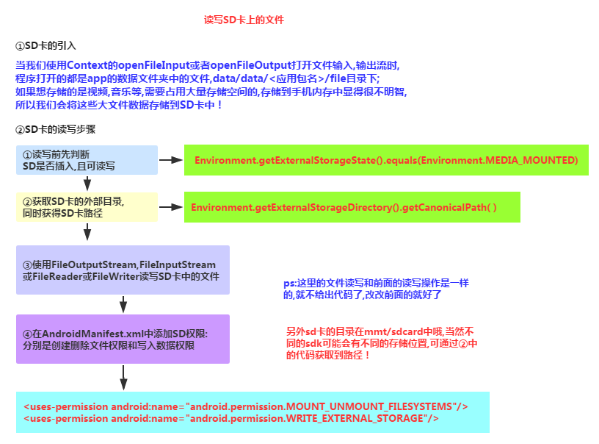
main_activity.xml:
<LinearLayout xmlns:android="http://schemas.android.com/apk/res/android"
xmlns:tools="http://schemas.android.com/tools"
android:id="@+id/LinearLayout1"
android:layout_width="match_parent"
android:layout_height="match_parent"
android:orientation="vertical"
tools:context="com.jay.example.filedemo2.MainActivity">
<TextView
android:layout_width="wrap_content"
android:layout_height="wrap_content"
android:text="清輸入文件名" />
<EditText
android:id="@+id/edittitle"
android:layout_width="match_parent"
android:layout_height="wrap_content"
android:hint="文件名" />
<TextView
android:layout_width="wrap_content"
android:layout_height="wrap_content"
android:text="清輸入文件內容" />
<EditText
android:id="@+id/editdetail"
android:layout_width="match_parent"
android:layout_height="wrap_content"
android:hint="文件內容" />
<Button
android:id="@+id/btnsave"
android:layout_width="wrap_content"
android:layout_height="wrap_content"
android:text="保存到SD卡" />
<Button
android:id="@+id/btnclean"
android:layout_width="wrap_content"
android:layout_height="wrap_content"
android:text="清空" />
<Button
android:id="@+id/btnread"
android:layout_width="wrap_content"
android:layout_height="wrap_content"
android:text="讀取sd卡中的文件" />
</LinearLayout>
接著我們來寫一個SD操作類: SDFileHelper.Java
public class SDFileHelper {
private Context context;
public SDFileHelper() {
}
public SDFileHelper(Context context) {
super();
this.context = context;
}
//往SD卡寫入文件的方法
public void savaFileToSD(String filename, String filecontent) throws Exception {
//如果手機已插入sd卡,且app具有讀寫sd卡的權限
if (Environment.getExternalStorageState().equals(Environment.MEDIA_MOUNTED)) {
filename = Environment.getExternalStorageDirectory().getCanonicalPath() + "/" + filename;
//這裡就不要用openFileOutput了,那個是往手機內存中寫數據的
FileOutputStream output = new FileOutputStream(filename);
output.write(filecontent.getBytes());
//將String字符串以字節流的形式寫入到輸出流中
output.close();
//關閉輸出流
} else Toast.makeText(context, "SD卡不存在或者不可讀寫", Toast.LENGTH_SHORT).show();
}
//讀取SD卡中文件的方法
//定義讀取文件的方法:
public String readFromSD(String filename) throws IOException {
StringBuilder sb = new StringBuilder("");
if (Environment.getExternalStorageState().equals(Environment.MEDIA_MOUNTED)) {
filename = Environment.getExternalStorageDirectory().getCanonicalPath() + "/" + filename;
//打開文件輸入流
FileInputStream input = new FileInputStream(filename);
byte[] temp = new byte[1024];
int len = 0;
//讀取文件內容:
while ((len = input.read(temp)) > 0) {
sb.append(new String(temp, 0, len));
}
//關閉輸入流
input.close();
}
return sb.toString();
}
}
接著MainActivity.java實現相關邏輯:
public class MainActivity extends AppCompatActivity implements View.OnClickListener{
private EditText editname;
private EditText editdetail;
private Button btnsave;
private Button btnclean;
private Button btnread;
private Context mContext;
@Override
protected void onCreate(Bundle savedInstanceState) {
super.onCreate(savedInstanceState);
setContentView(R.layout.activity_main);
mContext = getApplicationContext();
bindViews();
}
private void bindViews() {
editname = (EditText) findViewById(R.id.edittitle);
editdetail = (EditText) findViewById(R.id.editdetail);
btnsave = (Button) findViewById(R.id.btnsave);
btnclean = (Button) findViewById(R.id.btnclean);
btnread = (Button) findViewById(R.id.btnread);
btnsave.setOnClickListener(this);
btnclean.setOnClickListener(this);
btnread.setOnClickListener(this);
}
@Override
public void onClick(View v) {
switch (v.getId()){
case R.id.btnclean:
editdetail.setText("");
editname.setText("");
break;
case R.id.btnsave:
String filename = editname.getText().toString();
String filedetail = editdetail.getText().toString();
SDFileHelper sdHelper = new SDFileHelper(mContext);
try
{
sdHelper.savaFileToSD(filename, filedetail);
Toast.makeText(getApplicationContext(), "數據寫入成功", Toast.LENGTH_SHORT).show();
}
catch(Exception e){
e.printStackTrace();
Toast.makeText(getApplicationContext(), "數據寫入失敗", Toast.LENGTH_SHORT).show();
}
break;
case R.id.btnread:
String detail = "";
SDFileHelper sdHelper2 = new SDFileHelper(mContext);
try
{
String filename2 = editname.getText().toString();
detail = sdHelper2.readFromSD(filename2);
}
catch(IOException e){e.printStackTrace();}
Toast.makeText(getApplicationContext(), detail, Toast.LENGTH_SHORT).show();
break;
}
}
}
最後別忘記在AndroidManifest.xml寫上讀寫SD卡的權限哦!
<!-- 在SDCard中創建與刪除文件權限 --> <uses-permission android:name="android.permission.MOUNT_UNMOUNT_FILESYSTEMS"/> <!-- 往SDCard寫入數據權限 --> <uses-permission android:name="android.permission.WRITE_EXTERNAL_STORAGE"/>
如何判斷虛擬和物理兩種SDK
在默認情況下,會將一部分存儲空間分給虛擬的SD卡使用(一部分用於安裝Android操作系統)
android.os.Enviroment.isExternalStorageRemovalbe()
返回true:SD卡是物理的,反之SD卡是虛擬的。
用於適配不同型號手機,反射獲取SD卡路徑和狀態
package com.turing.base.activity.dataStore.fileStore;
import android.content.Context;
import android.os.Environment;
import android.os.StatFs;
import android.os.storage.StorageManager;
import android.text.TextUtils;
import android.util.Log;
import java.io.File;
import java.lang.reflect.InvocationTargetException;
import java.lang.reflect.Method;
import java.util.concurrent.ConcurrentLinkedQueue;
import java.util.concurrent.ExecutorService;
import java.util.concurrent.Executors;
/**
* 用於適配不同型號手機,反射獲取SD卡路徑和狀態
*
*/
public class DevMountInfo {
private final String TAG = DevMountInfo.class.getSimpleName();
private static final int ERROR = -1;
// class name
private final static String CLASS_NAME = "android.os.storage.StorageVolume";
//remained spare memory size
private static final int REMAINED_SPARE_IN_MB = 100;
// method name
private final static String METHOD_GET_VOLUME_LIST = "getVolumeList";
private final static String METHOD_GET_VOLUME_STATE = "getVolumeState";
private final static String METHOD_IS_REMOVABLE = "isRemovable";
private final static String METHOD_GET_PATH = "getPath";
private final static String MOUNTED = "mounted";
private static DevMountInfo INSTANCE;
private String mSDCardPath = null;
// internal file path
private ConcurrentLinkedQueue<String> mInternalPathList = new ConcurrentLinkedQueue<String>();
// external file path
private ConcurrentLinkedQueue<String> mExternalPathList = new ConcurrentLinkedQueue<String>();
private ExecutorService mExecutor = null;
private DevMountInfo() {
mExecutor = Executors.newSingleThreadExecutor();
}
public static DevMountInfo getInstance() {
synchronized (DevMountInfo.class) {
if (null == INSTANCE) {
INSTANCE = new DevMountInfo();
}
return INSTANCE;
}
}
@Override
protected void finalize() throws Throwable {
super.finalize();
synchronized (DevMountInfo.class) {
mInternalPathList.clear();
mExternalPathList.clear();
mExecutor.shutdown();
INSTANCE = null;
}
}
public void init(final Context context) {
mExecutor.execute(new Runnable() {
@Override
public void run() {
executeInit(context);
}
});
}
public boolean isSDCardFull() {
return REMAINED_SPARE_IN_MB > (getSDCardAvailSpace() * 1024);
}
public boolean isSDCardAvaiable() {
return !mExternalPathList.isEmpty() || !mInternalPathList.isEmpty();
}
public String getSDCardPath() {
return mSDCardPath;
}
public long getSDCardTotalSpace() {
long totalSpace = 0;
if (!TextUtils.isEmpty(mSDCardPath)) {
StatFs sf = new StatFs(mSDCardPath);
long blockSize = sf.getBlockSize();
long total = sf.getBlockCount();
totalSpace = total * blockSize / 1024;
}
return totalSpace;
}
public long getSDCardAvailSpace() {
long availSpace = 0;
if (!TextUtils.isEmpty(mSDCardPath)) {
StatFs sf = new StatFs(mSDCardPath);
long blockSize = sf.getBlockSize();
long availCount = sf.getAvailableBlocks();
availSpace = availCount * blockSize / 1024;
}
return availSpace;
}
public String getInternalSDCardPath() {
return mInternalPathList.peek();
}
public String getExternalSDCardPath() {
return mExternalPathList.peek();
}
private void executeInit(Context context) {
StorageManager mStorageManager = (StorageManager) context.getSystemService(Context.STORAGE_SERVICE);
if (mStorageManager != null) {
Class<?> mStorageVolume = null;
Method mGetVolumeListMethod = null;
Method mGetVolumeStateMethod = null;
Method mGetPathMethod = null;
Method mIsRemovableMethod = null;
Object[] mStorageVolumeList = null;
try {
mStorageVolume = Class.forName(CLASS_NAME);
mGetVolumeListMethod = mStorageManager.getClass().getMethod(METHOD_GET_VOLUME_LIST, new Class[0]);
mGetVolumeStateMethod = mStorageManager.getClass().getMethod(METHOD_GET_VOLUME_STATE, new Class[]{String.class});
mIsRemovableMethod = mStorageVolume.getMethod(METHOD_IS_REMOVABLE, new Class[0]);
mGetPathMethod = mStorageVolume.getMethod(METHOD_GET_PATH, new Class[0]);
mStorageVolumeList = (Object[]) mGetVolumeListMethod.invoke(mStorageManager, new Object[0]);
boolean mIsRemovable = false;
if (mStorageVolumeList != null && mStorageVolumeList.length > 0) {
int mStorageVolumeCount = mStorageVolumeList.length;
Log.i(TAG, "init() === > StorageVolume Count = " + mStorageVolumeCount);
mInternalPathList.clear();
mExternalPathList.clear();
for (int i = 0; i < mStorageVolumeCount; ++i) {
String mStoragePath = (String) mGetPathMethod.invoke(mStorageVolumeList[i], new Object[0]);
mIsRemovable = ((Boolean) mIsRemovableMethod.invoke(mStorageVolumeList[i], new Object[0])).booleanValue();
if (!TextUtils.isEmpty(mStoragePath)) {
String state = (String) mGetVolumeStateMethod.invoke(mStorageManager, new Object[]{mStoragePath});
if ((state != null) && (state.equals(MOUNTED))) {
if (mIsRemovable) {
Log.i(TAG, "init() === > external storage path = (" + mStoragePath + ")");
mExternalPathList.add(mStoragePath);
} else {
Log.i(TAG, "init() === > internal storage path = (" + mStoragePath + ")");
mInternalPathList.add(mStoragePath);
}
}
}
}
}
} catch (ClassNotFoundException e) {
handleInvalid();
Log.e(TAG, "init() === > Exception:ClassNotFoundException");
} catch (NoSuchMethodException e) {
handleInvalid();
Log.e(TAG, "init() === > Exception:NoSuchMethodException");
} catch (IllegalArgumentException e) {
handleInvalid();
Log.e(TAG, "init() === > Exception:IllegalArgumentException");
} catch (IllegalAccessException e) {
handleInvalid();
Log.e(TAG, "init() === > Exception:IllegalAccessException");
} catch (InvocationTargetException e) {
handleInvalid();
Log.e(TAG, "init() === > Exception:InvocationTargetException");
}
} else {
handleInvalid();
Log.e(TAG, "init() === > can't get storage manager");
}
initSDCardPath();
}
private void handleInvalid() {
mInternalPathList.add(Environment.getExternalStorageDirectory().getPath());
}
private void initSDCardPath() {
if (!mExternalPathList.isEmpty()) {
mSDCardPath = mExternalPathList.peek();
} else if (!mInternalPathList.isEmpty()) {
mSDCardPath = mInternalPathList.peek();
} else {
mSDCardPath = Environment.getExternalStorageDirectory().getPath();
}
Log.i(TAG, "initSDCardPath() === > SDCARD PATH = (" + mSDCardPath + ")");
}
/**
* SDCARD是否存
*/
public static boolean externalMemoryAvailable() {
return android.os.Environment.getExternalStorageState().equals(
android.os.Environment.MEDIA_MOUNTED);
}
/**
* 獲取手機內部剩余存儲空間
*
* @return
*/
public static long getAvailableInternalMemorySize() {
File path = Environment.getDataDirectory();
StatFs stat = new StatFs(path.getPath());
long blockSize = stat.getBlockSize();
long availableBlocks = stat.getAvailableBlocks();
return availableBlocks * blockSize;
}
/**
* 獲取手機內部總的存儲空間
*
* @return
*/
public static long getTotalInternalMemorySize() {
File path = Environment.getDataDirectory();
StatFs stat = new StatFs(path.getPath());
long blockSize = stat.getBlockSize();
long totalBlocks = stat.getBlockCount();
return totalBlocks * blockSize;
}
/**
* 獲取手機內置存儲剩余存儲空間
*
* @return
*/
public static long getAvailableInternalSystemMemorySize() {
File path = Environment.getRootDirectory();
StatFs stat = new StatFs(path.getPath());
long blockSize = stat.getBlockSize();
long availableBlocks = stat.getAvailableBlocks();
return availableBlocks * blockSize;
}
/**
* 獲取手機內置存儲總的存儲空間
*
* @return
*/
public static long getTotalInternalSystemMemorySize() {
File path = Environment.getRootDirectory();
StatFs stat = new StatFs(path.getPath());
long blockSize = stat.getBlockSize();
long totalBlocks = stat.getBlockCount();
return totalBlocks * blockSize;
}
/**
* 獲取SDCARD剩余存儲空間
*
* @return
*/
public static long getAvailableExternalMemorySize() {
if (externalMemoryAvailable()) {
File path = Environment.getExternalStorageDirectory();
StatFs stat = new StatFs(path.getPath());
long blockSize = stat.getBlockSize();
long availableBlocks = stat.getAvailableBlocks();
return availableBlocks * blockSize;
} else {
return ERROR;
}
}
/**
* 獲取SDCARD總的存儲空間
*
* @return
*/
public static long getTotalExternalMemorySize() {
if (externalMemoryAvailable()) {
File path = Environment.getExternalStorageDirectory();
StatFs stat = new StatFs(path.getPath());
long blockSize = stat.getBlockSize();
long totalBlocks = stat.getBlockCount();
return totalBlocks * blockSize;
} else {
return ERROR;
}
}
public static long getAvailableMemorySize(String path) {
if (null == path)
return 0;
StatFs stat = new StatFs(path);
long blockSize = stat.getBlockSize();
long availableBlocks = stat.getAvailableBlocks();
return availableBlocks * blockSize;
}
}
讀取raw和assets文件夾下的文件
相信大家對兩個文件夾並不陌生,如果我們不想自己的文件被編譯成二進制文件的話, 我們可以把文件放到這兩個目錄下,而兩者的區別如下:
讀取文件資源:
res/raw:
InputStream is =getResources().openRawResource(R.raw.filename);
assets:
AssetManager am = getAssets();
InputStream is = am.open("filename");
SAX引擎讀取XML文件
sax引擎讀取xml文件的原理:
sax技術在處理xml文件時並不一次性把xml文件裝入內存,而是一邊讀一般解析。
使用sax處理xml需要一個Handler對象,一般會使用org.xml.sax.helpers.DefaultHandler的子類作為Handler對象
因此,這就需要處理如下5個分析點,也可稱為分析事件:
Code
res\raw\product.xml
<?xml version="1.0" encoding="utf-8"?>
<products>
<product>
<id>10</id>
<name>電腦</name>
<price>2067.25</price>
</product>
<product>
<id>20</id>
<name>微波爐</name>
<price>520</price>
</product>
<product>
<id>30</id>
<name>洗衣機</name>
<price>2400</price>
</product>
</products>
Product.java
public class Product
{
private int id;
private String name;
private float price;
public int getId()
{
return id;
}
public void setId(int id)
{
this.id = id;
}
public String getName()
{
return name;
}
public void setName(String name)
{
this.name = name;
}
public float getPrice()
{
return price;
}
public void setPrice(float price)
{
this.price = price;
}
}
XML2Product.java(DefaultHandler子類)
DefaultHandler子類 ,核心類,負責處理分析點事件。
import org.xml.sax.Attributes;
import org.xml.sax.SAXException;
import org.xml.sax.helpers.DefaultHandler;
import java.util.ArrayList;
import java.util.List;
public class XML2Product extends DefaultHandler {
private List<Product> products;
private Product product;
private StringBuffer buffer = new StringBuffer();
public List<Product> getProducts() {
return products;
}
@Override
public void characters(char[] ch, int start, int length)
throws SAXException {
buffer.append(ch, start, length);
super.characters(ch, start, length);
}
@Override
public void startDocument() throws SAXException {
// 開始分析xml文件,創建List對象用於保存分析完的Product對象
products = new ArrayList<Product>();
}
@Override
public void startElement(String uri, String localName, String qName,
Attributes attributes) throws SAXException {
if (localName.equals("product")) {
// 如果分析的是<product>標簽,則創建一個Product對象
product = new Product();
}
super.startElement(uri, localName, qName, attributes);
}
@Override
public void endElement(String uri, String localName, String qName)
throws SAXException {
if (localName.equals("product")) {
// 處理完 <product>標簽後 將product對象添加到products中
products.add(product);
} else if (localName.equals("id")) {
// 設置id屬性的值
product.setId(Integer.parseInt(buffer.toString().trim()));
// 將標簽內容的緩存區清空
buffer.setLength(0);
} else if (localName.equals("name")) {
product.setName(buffer.toString().trim());
buffer.setLength(0);
} else if (localName.equals("price")) {
product.setPrice(Float.parseFloat(buffer.toString().trim()));
buffer.setLength(0);
}
super.endElement(uri, localName, qName);
}
}
Xml2JavaObjectAct
import android.app.AlertDialog;
import android.os.Bundle;
import android.support.v7.app.AppCompatActivity;
import android.util.Xml;
import android.view.View;
import com.turing.base.R;
import java.io.InputStream;
import java.util.List;
public class Xml2JavaObjectAct extends AppCompatActivity {
@Override
protected void onCreate(Bundle savedInstanceState) {
super.onCreate(savedInstanceState);
setContentView(R.layout.activity_xml2_java_object);
}
public void onClick_XMLToObject(View view) {
try {
// 打開資源文件
InputStream is = getResources().openRawResource(R.raw.products);
XML2Product xml2Product = new XML2Product();
// 開始分析priducts.xml文件
android.util.Xml.parse(is, Xml.Encoding.UTF_8, xml2Product);
// 輸出轉換後的java對象
List<Product> products = xml2Product.getProducts();
String msg = "共" + products.size() + "個產品\n";
for (Product product : products) {
msg += "id:" + product.getId() + " 產品名:" + product.getName()
+ " 價格:" + product.getPrice() + "\n";
}
// 彈出對話框
new AlertDialog.Builder(this).setTitle("產品信息").setMessage(msg)
.setPositiveButton("關閉", null).show();
} catch (Exception e) {
}
}
}
效果圖
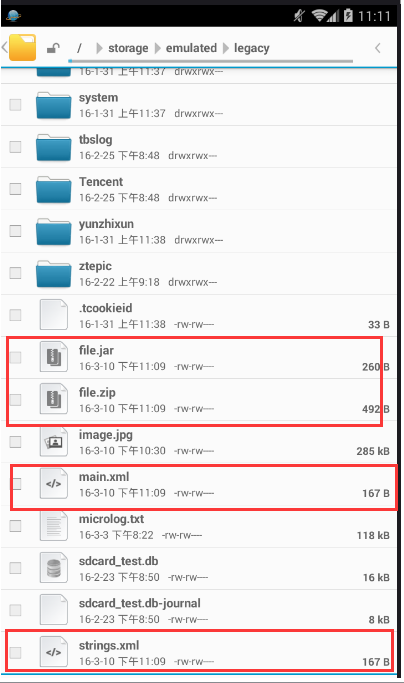
Code
activity_jar_zip.xml
<?xml version="1.0" encoding="utf-8"?>
<LinearLayout xmlns:android="http://schemas.android.com/apk/res/android"
android:layout_width="fill_parent"
android:layout_height="fill_parent"
android:orientation="vertical" >
<Button
android:layout_width="fill_parent"
android:layout_height="wrap_content"
android:onClick="onClick_Jar_Compress"
android:text="用jar格式壓縮文件" />
<Button
android:layout_width="fill_parent"
android:layout_height="wrap_content"
android:onClick="onClick_Jar_Uncompress"
android:text="解壓jar格式文件" />
<Button
android:layout_width="fill_parent"
android:layout_height="wrap_content"
android:onClick="onClick_Zip_Compress"
android:text="用zip格式壓縮文件" />
<Button
android:layout_width="fill_parent"
android:layout_height="wrap_content"
android:onClick="onClick_Zip_Uncompress"
android:text="解壓zip格式文件" />
</LinearLayout>
JarZipAct
import android.os.Bundle;
import android.support.v7.app.AppCompatActivity;
import android.view.View;
import android.widget.Toast;
import com.turing.base.R;
import java.io.File;
import java.io.FileInputStream;
import java.io.FileOutputStream;
import java.io.InputStream;
import java.util.jar.JarEntry;
import java.util.jar.JarInputStream;
import java.util.jar.JarOutputStream;
import java.util.zip.ZipEntry;
import java.util.zip.ZipInputStream;
import java.util.zip.ZipOutputStream;
public class JarZipAct extends AppCompatActivity {
@Override
protected void onCreate(Bundle savedInstanceState) {
super.onCreate(savedInstanceState);
setContentView(R.layout.activity_jar_zip);
}
public void onClick_Jar_Compress(View view) {
try {
// 使用FileOutputStream對象指定一個要輸出的壓縮文件(file.jar)
FileOutputStream fos = new FileOutputStream(
android.os.Environment.getExternalStorageDirectory()
+ "/file.jar");
// 第一步 創建JarOutputStream對象
JarOutputStream jos = new JarOutputStream(fos);
// 第二步 創建一個JarEntry對象,並指定待壓縮文件在壓縮包中的文件名
JarEntry jarEntry = new JarEntry("strings.xml");
jos.putNextEntry(jarEntry);
InputStream is = getResources().getAssets().open("strings.xml");
byte[] buffer = new byte[8192];
int count = 0;
// 第四步 寫入數據
while ((count = is.read(buffer)) >= 0) {
jos.write(buffer, 0, count);
}
// 第五步 關閉當前的JarEntry等對象
is.close();
jos.closeEntry();
jos.close();
Toast.makeText(this, "成功將strings.xml文件以jar格式壓縮.", Toast.LENGTH_LONG)
.show();
} catch (Exception e) {
Toast.makeText(this, e.getMessage(), Toast.LENGTH_LONG).show();
}
}
public void onClick_Jar_Uncompress(View view) {
try {
// 定義要解壓的文件
String filename = android.os.Environment
.getExternalStorageDirectory() + "/file.jar";
if (!new File(filename).exists()) {
Toast.makeText(this, "壓縮文件不存在.", Toast.LENGTH_LONG).show();
return;
}
// 使用FileInputStream對象指定要解壓的對象
FileInputStream fis = new FileInputStream(filename);
// 1 創建JarInputStream對象來讀取壓縮文件(file.jar)
JarInputStream jis = new JarInputStream(fis);
// 2 調用getNextJarEntry方法打開壓縮包中的第一個文件 ,如果有多個,多次調用該方法
JarEntry jarEntry = jis.getNextJarEntry();
// 3 輸出已解壓的文件
FileOutputStream fos = new FileOutputStream(
android.os.Environment.getExternalStorageDirectory()
+ "/" + jarEntry.getName());
byte[] buffer = new byte[8192];
int count = 0;
// 4 輸出已解壓的字節流
while ((count = jis.read(buffer)) >= 0) {
fos.write(buffer, 0, count);
}
// 5 關閉
jis.closeEntry();
jis.close();
fos.close();
Toast.makeText(this, "成功解壓jar格式的文件.", Toast.LENGTH_LONG).show();
} catch (Exception e) {
Toast.makeText(this, e.getMessage(), Toast.LENGTH_LONG).show();
}
}
public void onClick_Zip_Compress(View view) {
try {
// 指定了2個待壓縮的w文件,都在assets目錄中
String[] filenames = new String[]
{"main.xml", "strings.xml"};
FileOutputStream fos = new FileOutputStream(
android.os.Environment.getExternalStorageDirectory()
+ "/file.zip");
ZipOutputStream zos = new ZipOutputStream(fos);
int i = 1;
//枚舉filenames中的所有待壓縮文件
while (i <= filenames.length) {
// 從filenames數組中取出當前待壓縮的溫佳明,作為壓縮後的文件名,以保持要說前後文件名稱一致
ZipEntry zipEntry = new ZipEntry(filenames[i - 1]);
// 打開當前的ZipEntry對象
zos.putNextEntry(zipEntry);
InputStream is = getResources().getAssets().open(
filenames[i - 1]);
byte[] buffer = new byte[8192];
int count = 0;
// 寫入數據
while ((count = is.read(buffer)) >= 0) {
zos.write(buffer, 0, count);
}
zos.flush();
// 關閉當前的ZipEntry對象
zos.closeEntry();
is.close();
i++;
}
zos.finish();
zos.close();
Toast.makeText(this, "成功將main.xml、strings.xml文件以zip格式壓縮.",
Toast.LENGTH_LONG).show();
} catch (Exception e) {
Toast.makeText(this, e.getMessage(), Toast.LENGTH_LONG).show();
}
}
public void onClick_Zip_Uncompress(View view) {
try {
// 指定待解壓的文件
String filename = android.os.Environment
.getExternalStorageDirectory() + "/file.zip";
if (!new File(filename).exists()) {
Toast.makeText(this, "壓縮文件不存在.", Toast.LENGTH_LONG).show();
return;
}
FileInputStream fis = new FileInputStream(filename);
ZipInputStream zis = new ZipInputStream(fis);
ZipEntry zipEntry = null;
// 通過不斷調用getNextEntry方法來解壓file.zip中所有的文件
while ((zipEntry = zis.getNextEntry()) != null) {
FileOutputStream fos = new FileOutputStream(
android.os.Environment.getExternalStorageDirectory()
+ "/" + zipEntry.getName());
byte[] buffer = new byte[8192];
int count = 0;
while ((count = zis.read(buffer)) >= 0) {
fos.write(buffer, 0, count);
}
zis.closeEntry();
fos.close();
}
zis.close();
Toast.makeText(this, "成功解壓jar格式的文件.", Toast.LENGTH_LONG).show();
} catch (Exception e) {
Toast.makeText(this, e.getMessage(), Toast.LENGTH_LONG).show();
}
}
}
原文鏈接:http://blog.csdn.net/yangshangwei/article/details/50831269
以上就是本文的全部內容,希望對大家的學習有所幫助,也希望大家多多支持本站。
 android系統在靜音模式下關閉camera拍照聲音的方法
android系統在靜音模式下關閉camera拍照聲音的方法
話說為了防止偷拍,業內有不成文規定,手機公司在做camera時,點擊拍照和錄像鍵的時候,必須要有提示音。因此,google也就非常人性化的將播放拍照聲音的函數,放到了ca
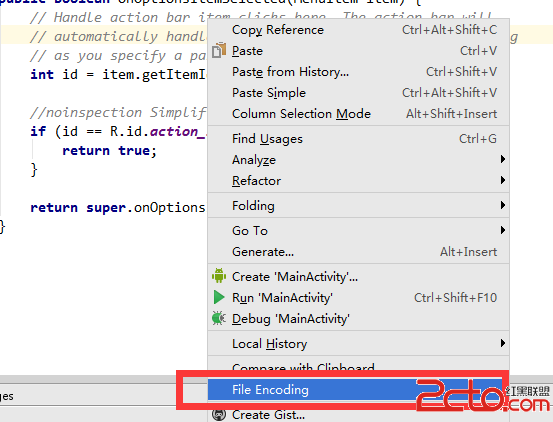 【項目篇】Android團隊項目開發之統一代碼規范
【項目篇】Android團隊項目開發之統一代碼規范
前言團隊項目開發前的統一三要素:統一需求/開發文檔,統一代碼規范,統一環境(編譯/測試/發布)。一個項目團隊,要想有高效的產出,必須在團隊協作上下好功夫,必須在項目開發統
 Android Drawable及其相關類的使用
Android Drawable及其相關類的使用
一個讓人賞心悅目的界面對軟件來說非常重要,因此圖形圖像資源也顯得非常重要。本講就要談一談Android中處理圖形圖像的最重要的一個類Drawable。Drawable就是
 華為榮耀8護眼模式怎麼開啟
華為榮耀8護眼模式怎麼開啟
在我們使用手機的時候,由於眼睛需要正對著屏幕,隨著時間的增加,就會引起眼睛疲勞,不適,以及近視等問題,所以我們在使用手機的時候盡量要控制好使用時間,保護好自